The Effects Of The Ayahuasca Ceremony On Participants As Measured By qEEG And The Cognitive Emotional Checklist
By Luke Jensen, BA
Abstract
Ayahuasca is a plant from the Amazon jungle that has been used shamanically for both psychological healing and mystical experiences. Though the plant has been used traditionally for hundreds of years or more, recently it has become a topic of more global interest, especially in the West as means of healing and spiritual connection.
Many people around the world have traveled to the Amazon and have experienced Ayahuasca. The challenge for modern scientific research is how to quantify these experiences. In this study we use both pre and post QEEG brain mapping and a specially designed questionnaire called a Cognitive Emotional Checklist (CEC), an emotional/mental self-inventory targeting brain function. To our knowledge this type of study has not been conducted in the field of Ayahuasca research.
In this study we found that each person’s brain appeared to respond uniquely and there was a wide variety of differences between the pre and post maps although very significant changes occurred in each case. The Pre and post CEC indicated that many individuals experienced a dramatic reduction in negative symptomology. We conclude that the effect of Ayahuasca is highly individualized but very effective in producing positive changes.
Literature Review
After decades of almost no research whatsoever, there has arisen a renewed scientific interest in psychedelics. This has corresponded with rapidly changing popular sentiment in relation to the psychedelic experience. A significant part of the general public has begun to express more curiosity about psychedelics and are interested in what these plants have to offer. At the same time, a large part of the scientific community is seeking to explore, document, and understand psychedelics for the first time. Of these, Ayahuasca has become one of the most well-known substances for healing and spiritual communion. Ayahuasca is a sacred tea/brew made by indigenous tribes of the Amazon for hundreds of years or as some anthropologists believe even thousands of years. Ayahuasca is a sacred spiritual medicine to the tribes in the Amazon that use it ceremonially. In the late 20th century and especially the early 21st century, it has become more popular for Westerners to travel and partake in the shamanic ritual of drinking Ayahuasca. Ayahuasca is a combination of plants creating the desired psychedelic effect. Ayahuasca tea contains two ingredients Banisteriopsis caapi and Psychotria viridis. These ingredients contain a combination of the psychedelic indole N, N-dimethyltryptamine (DMT) from P. viridis, and β-carboline (harmala) alkaloids with monoamine-oxidase inhibiting properties from B. caapi (McKenna et al., 19841). Usually DMT is digested in the stomach but when combined with the MAO inhibitors of Banisteriopsis caapi renders the DMT orally active (Riba et al., 20062).
It is sometimes said that psychedelics are entering a “New Renaissance” and much research is being done into the healing characteristics of these substances. In the past it was common belief that psychedelics elicit negative effects on the human biological system, but current research does not support this. The National Survey on Drug Use and Health demonstrated that psychedelics taken over a lifetime are associated with significant reduction of suicidal thoughts and psychological distress (Hendricks et al. 20153). In addition, it has been observed after a one year follow up into the long-term effects found no negative effects on psychological health or cognitive abilities (Bouso et al. 20154). Like many new paradigms it takes time for much of the scientific community to catch up (Kuhn, 20045). Finally, after many years of government suppression and a large amount of cultural ignorance, psychedelics are becoming more widely used for spiritual practices and healing. There seem to be many cultural drivers for this and in many ways the thrust of this new paradigm shift has come from the ground up, from people like podcasters and others in the cultural sphere sharing their experiences. Scientists in turn are investigating what is being reported.
Unlike many previous studies, this study was done in a traditional setting with an indigenous Shipibo Shaman. An important question arises on how to precisely study psychedelics. The revival of interest in psychedelic medicines has largely been divided into two methods. The first and most common method has been in the laboratory setting which thus far has yielded positive mental health outcomes (Gregorio et al, 20216). The second, less common method is to investigate psychedelics in their natural environment, in a shamanic setting. This method has received significantly less research attention (Weiss et al, 20217). Although Ayahuasca is found in the Amazon jungle it is often taken in other places for ceremonial purposes. The following study was conducted in the Sacred Valley of Peru, a pastoral region of the country outside Cusco, the ancient capital of the Incan Empire. This study was not done in a clinical setting but a much more natural setting where Ayahuasca is typically experienced. It is postulated that the Ayahuasca experience is enhanced in a natural setting, with a traditional practices more likely increases the impact of the experience upon the individual (Pontual et al 20228). Additionally, exploring different healing methods outside strict clinical standards ie, in their natural setting, may give additional insight to the healing process.
Ayahuasca shamanism with sacred ceremonies are highly complex proceedings. To the Shipibo tribes of the Amazon, Ayahuasca is much more than a simple hallucination or psychological experience. The Ayahuasca plant itself contains a powerful spirit that heals people on many different levels, particularly the spiritual and energetic level. This idea of healing energetically has parallels to other cultures such as Chi and Prana (Beissner, 20209). In the Shipibo tradition the shaman is a facilitator, and the plants spirits are the true healers. Both work in tandem to heal. The Shaman studies for years to learn sacred songs of the plants called icaros, and sings these songs during the ceremony. The plant spirits and the Shaman work together to remove “dirty” and diseased energies in the Shipibo language known as “mahua yoshin” understood to be energies/spirits of the dead (Weiss, 202110). The process can also be thought of as the cleaning of the energy body that is described in other traditions although shamanism contains much more complexity that is learned over years of dedicated practice and training as an apprentice under another shaman (Brabec, 202111).
Ayahuasca shamanism itself it part of the larger drive of human beings to connect with something “greater” beyond themselves. This quest for connecting with the divine comes in many forms. Whether through meditation, shamanism, prayer, or other methods such paradigms often give a person a profound insight into the nature of the universe and reality itself. It has been documented that these experiences are accompanied with sudden, substantial, and sustained changes in behavior and perception (Miller et al, 200112).
It has been demonstrated that psychedelic compounds like psilocybin can have profound effect and result in strong mystical experiences (Griffiths et al, 201113) and that these experiences can have strong personal meaning (Griffiths et al, 200614). In addition, these mystical experiences seem to have a profound and persisting positive effects on attitudes, mood, and behavior.
The study of psychedelics and mystical experiences are shedding light into new potential avenues of healing and psychic wholeness. In two different study groups after a 14 month follow up after the use of psilocybin, 58% and 67% of each group respectively, rated the psilocybin experience as being among the five most personally meaningful and spiritually significant experiences in of their lives (Griffiths et al, 200815). This should be astonishing data for those in modern Western medicine looking for alternatives. It has been well documented that so much of modern illness is related to stress and other mental conditions (Schneiderman, et al, 200816)). Instead of treating the symptoms with prescription drugs, what if individuals having a mystical experience could offer themselves deep psychological healing? Could this help restore the overall health of the individual? The mystical experience has been a core part of this physiological healing throughout the ages. One of the major facilitators of such experiences has been the use of psychedelic plants. As we go forward in this study it is important to keep in mind that what we are studying is more than just the acute effect of the psychedelic on the neurophysiology but the psychological and spiritual impact that the psychedelic experience has on the whole being.
Previous studies have seemed to demonstrate both acute and long-term effects of psychedelics. Today’s research indicates psychedelics like Ayahuasca are powerful tools to expand the human experience and heal from trauma and other psychological ailments (Des Santos et al., 201617). The purpose of this study is to further investigate changes in the brain through QEEG analysis and participant self-reporting in a traditional shamanic setting. It was our goal to continue this research to further understand both the neurological changes and cognitive/behavioral changes that can take place after using Ayahuasca in a shamanic setting. Much work has been done about what happens neurologically during a psychedelic experience, but little research has been done on the longer-term impact especially in relation to QEEG brain mapping. QEEG brain mapping has been used during the active experience of taking the psychedelic itself, but more research needs to be done on longer term impact. Even in the realm of long-term self-reports and questionnaires, many avenues of research are yet to be done in this field.
QEEG brain mapping has become a much more powerful tool in recent years. Brain mapping can indicate issues with mood such as anxiety and depression. Areas of the brain that are dysregulated or out of norm by one or more standard deviations have statistical impact on different types of neurological functions that affect behavior, mood, and cognitive function. Modern QEEG brain mapping allows the researcher to see changes over time. Changes can be seen in the brain on multiple levels whether its changes in anxiety or depression or other cognitive functions like inflammatory processes caused by head trauma. Changes can be observed in general neuro plasticity and when the brain is moving into a more normative and regulated direction. These type of change in neuroplasticity are very important measures in neurological health. Such changes are highly correlated to both psychological health and proper cognitive function. In short, modern tools of QEEG analysis hold much promise for present and future research in the realm of psychedelics.
Recently more research has been done in the terms of QEEG and other types of neuroimaging with Ayahuasca and other psychedelics. Studies of neurophysiological impact of Ayahuasca have demonstrated a suppression of the inhibitory alpha rhythm in the occipital and parietal cortex, including the posterior cingulate cortex (PCC), highly important node of the Default Mode Network (DMN) where the sense of self and consciousness are prominent (Schenberg et al, 201518). To bring the study of Ayahuasca back to the understanding of the mystical experience it is important to understand how the DMN is related to such experience. The sense of unity that is highly correlated to the mystical experience involves a decrease in self-referential processing. Evidence strongly supports that the DMN is involved in self-referential processing. Multiple different types of methods such as meditation and the ingestion of psychedelics have shown upon investigation a decrease in activity in the DMN (Riba et al, 200219).
This decrease of energy in the Default Mode Network is highly correlated to the sense of self. The evidence appears to suggest that the unity or transcendental experiences that are often described is related to the decreased activity in the DMN. For example, experienced meditators with a years of mindfulness practice demonstrated a decreased activity in the DMN compared to non-meditators (Brewer et al. 201120). Additional studies have demonstrated that meditation is a unique state compared to relaxation and does not have the same EEG signature. Focus meditation has shown a unique EEG and blood perfusion pattern at the 10-20 site P4. This is a key area of the DMN that is associated for the purpose of distinguishing self from others. Both measurements of EEG and hypoperfusion measures indicate that the PZ area is highly under-activated in meditation and once again points to a profound sense of unity and oneness as related to the DMN slowing down (Soutar, 202221). Psilocybin has been demonstrated to produce significant decreases in oscillatory power in the DMN as well (Muthukumaraswamy et al 201322). Recent fMRI studies have al demonstrated decreased blood flow in the regions of the DMN in relation to psilocybin infusion (Carhart-Harris et al 201223).
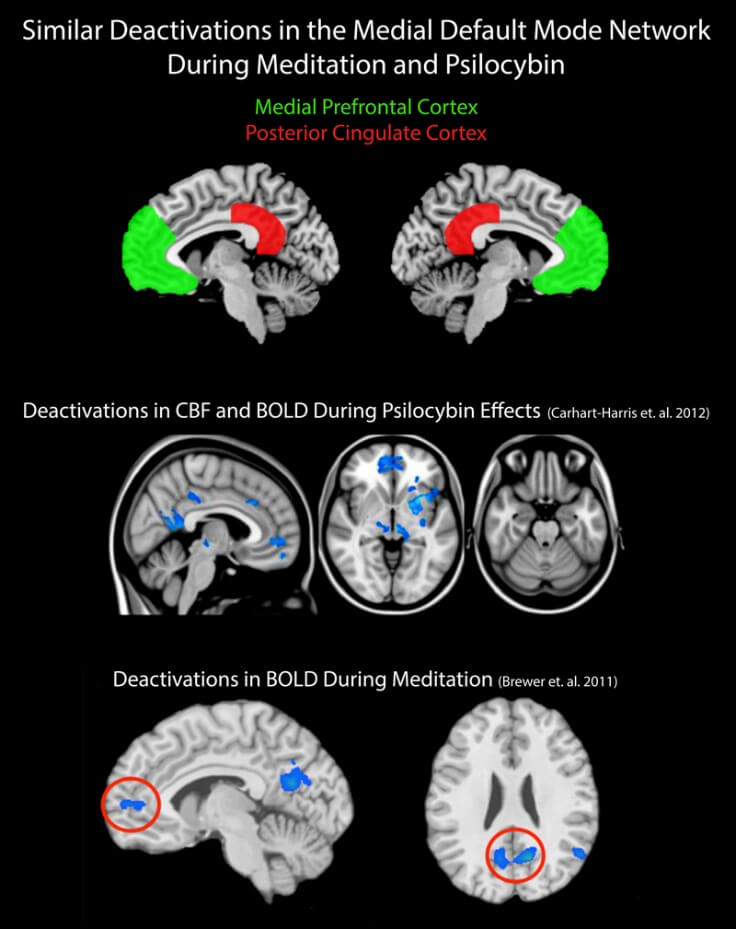
Though the DMN seems to be one of the most impacted area in psylocibin, other areas of the brain are affected too. It has been observed that frontal parietal connectivity is associated with rumination in depressive states. It has been found in previous studies that frontal-parietal activity decreases after psilocybin infusion and this breakdown of brain networks proves to be a fundamental feature of the psychedelic states and is related to the therapeutic effect (Muthukumaraswamy et al 201324). In addition, though activity in the DMN decreases with the injection of psychedelics, it has been demonstrated that psilocybin and LSD acutely increases DMN-TPN connectivity and other cross talk between networks. It is suggested that cross talk lingers beyond the initial experience of the psychedelic itself acute and contributes to the “after-glow” which results in increased mindfulness capacities (Barret et al, 201925).
Though there has been research of the effects on psychedelics and Ayahuasca during the acute phase of the experience there has been little to no research comparing brain QEEG pre and post experience. The neurofeedback QEEG model has significant potential as a research tool in this area. In addition, questionnaires designed to relate to QEEG measurements and neurophysiology can add further evidence into how the individual is affected post experience. Anxiety and depression, as modern research is indicating, are the universal responses to social stress and disease (McEwen, 200726). The model emerging supports the model that depression is an advanced form of anxiety where the biological human system becomes exhausted due to energy depletion. Before the pharmaceutical model and the widespread use of prescription drugs, psychiatry saw anxiety as the basis for all disorder and depression as a result of anxiety (Soutar, 202227). Anxiety and depression can be measured by QEEG and the metabolic correlates of the QEEG. This allows neurofeedback practitioners to track recovery from disorder (Soutar, 202228). The use of this technology to measure the relief of such symptoms in the realm of psychedelics offers enormous potential. In addition, the use of pre and post questionnaires relating to neurophysiological health add a further measure of insight and validation.
The reality that seems to be emerging due to recent neuroimaging research demonstrates the highly correlated nature of mental disorder and neural health. As mentioned previously, the anxiety depression model appears to hold increased validity with neuroimaging supporting this hypothesis. Indeed, the evidence strongly supports the postulate of anxiety being the root of mental disorder. Anxiety is far more than just a mental state, as neuro imaging technology is discovering but has profound effects on overall neurological health. It has been observed that anxiety results in the disconnection between subcortical limbic structures and the cortex itself (LeDoux 201529). Fear circuits in the brain that are activated in the anxiety process gradually wear out the brain structures through inflammatory processes which result in reduced cognitive function. All these processes are interrelated and how such processes are affected by psychedelic experiences offers wide swaths of areas for future research. Could the reduction of activity of the fear circuitry in the brain offer the space it needs to heal? Can these exceptional plants themselves reduce the inflammatory process, thus leading to greater mental stability? Is it the achievement of the mystical state itself and the sense of oneness accompanying the sensation of “quieting the mind” allowing for the calming of neuro circuits? There are likely many other possibilities besides these and the more research and research tools that come to bare on these questions the more likely we will find answers.
Lastly, we designed our method of study in such a way that temporal change between pre and post QEEG was of primary interest. In addition, the Cognitive Emotional Checklist questionnaire was added to confirm and validate observations in the QEEG and is a critical part of our analysis. Based on previous findings we expected changes in the self-reporting of the individuals in the CEC and changes in the QEEG that would indicate a relief from depression and anxiety. Unlike many other studies, we wanted to have a pre and post QEEG, not a QEEG during the experience itself. This method was intended to focus on the changes taking place after the experience but not the acute changes taking place during the experience as most of the research so far has emphasized this paradigm.
Previous studies have found that psychedelics can have a profound positive impact on anxiety and depression. One study performed on people with terminal cancer found those that who received psilocybin mushrooms “produced immediate, substantial, and sustained improvements in anxiety and depression and led to decreases in cancer-related demoralization and hopelessness, improved spiritual wellbeing, and increased quality of life (Ross et al, 201630).” Other studies have demonstrated improved mental health outcomes that were sustained over time (Carhart-Harris et al, 201831) (Barret et al, 202032). As other demonstrated increased psychological health, especially in the realms of anxiety and depression, we expected these measures of decreased anxiety and depression to be validated in the QEEG. We also expected these measures to be validated with the CEC. Based on previous experience we hypothesized the QEEG brain maps might indicate overall less power or high delta because of the lack of sleep.
Subjects
The study consisted of five people, two men and three women ranging in age from 25 to 46. All were gainfully employed and one self employed. All subjects were from the United States except one subject was from Australia. All five subjects were part of an Ayahuasca creativity retreat conducted by the CEO of Leadershipedelics.
Methods
The study was conducted at the retreat center Munay Sonqo in the Sacred Valley of Peru. Each participant received a QEEG brain map the day prior to their first Ayahuasca ceremony. Each participant took part in three Ayahuasca ceremonies, three days in a row and the post QEEG was taken the day following the participants’ last ceremony. The Study was conducted utilizing a nineteen sensor QEEG cap with linked ears montage. The QEEGs were taken using serial acquisition with a four-channel amplifier made by New Mind Technologies. Both eyes closed and eyes open maps were completed with each person. The brain maps sessions were conducted overlooking mountains in the natural beauty of Peruvian countryside. The QEEG brain maps were edited for artifact and processed though the New Mind Technologies data base. The New Mind Technologies data base evaluates both normalization and plasticity. The New Mind Technologies plasticity measurement measures amount of flexibility change in the brain and normalization measures how much the brain moves into a normative distribution. Both these measurements indicate whether a brain is fluid or rigid. Additionally New Mind Technologies map system measures these changes in a percentage format. According to this system, a 38% change is the norm after a complete neurofeedback treatment. An average change day to day is 15% to 20%.
In addition, as each participant was having a QEEG brain map completed, others were taking the Cognitive Emotional Checklist (CEC) provided by New Mind Technologies. The CEC is a self-inventory taken by the client that evaluates problems with attention, filtering, mood, and factors related to cognitive performance. The evaluation relates self reported problems with likely areas of the brain that are dysregulated. The client’s QEEG is then compared to their CEC to validate findings.
Results
From this initial study it appears each person’s brain moved in a way that was “needed.” Each person had a unique neurological response to the plant medicine. Possible confounds was the retreat included other modalities including one guided meditation, 45 min yoga class, 2 x 2-hour music workshops/breathwork, 1 x 2-hour art workshop offered during the creativity retreat. From previous experience Ayahuasca seems to have the largest impact though other modalities likely play a role as well. The retreat resulted in many different changes in the brain that both increased neuroplasticity and regulation of neural structures.
Each person experienced a significant amount of neuroplasticity and change as measured by the New Mind mapping system. Each individual’s brain moved a significant degree towards a normative direction. Every participant also experienced a change in the connectivity between the major brain network hubs implying large new neuronal connections were being made or being used more efficiently.
In addition, all participants took the Cognitive Emotional Checklist (CEC) self-inventory pre and post Ayahuasca ceremonies. The CEC allowed the participant to self-evaluate mood and other cognitive characteristics. Each person experienced a change in a positive direction with some participants experiencing a significant amount of change.
From this study, data suggests that Ayahuasca in a retreat setting with other modalities can have a wide variety of effects on the brain unique to the individual. Each person’s brain moved in a direction most conducive to their own healing.
Each participant experienced a massive amount of brain plasticity as well. This plasticity was experienced in many ways from change in overall power levels in the Delta, Theta, Alpha, Beta spectrums, to network connections, and alpha and beta asymmetries (measures of depression and anxiety). Once again, the plasticity change was unique to each individual implying that each participant experienced more than just a physiological event but a profound psychological/spiritual event.
Research Subject 1 was a 46-year-old male.
QEEG results: His QEEG results indicated a 48% change in plasticity and a 44% change in normalization in his pre and post eyes closed map. He had a 45% change in plasticity and a 46% change in normalization during the eyes open map. His post map showed significant changes from the pre map in that the normalization and plasticity changes were significant. He had an overall power increase across all frequency bands with the most significant being in the slower waves of Delta and Theta. Overall, subject 1 experienced a significant slowing in his network connections which before were working at too high of a rate known in the field as hyper-connection. He stated he felt more “calm and relaxed”, and the healthy slowing of the network connections appear to display that. He also experienced a moderate level of power increase in his brain, both in his eyes closed and eyes open map, inflammation markers in the Delta band were decreased as well.
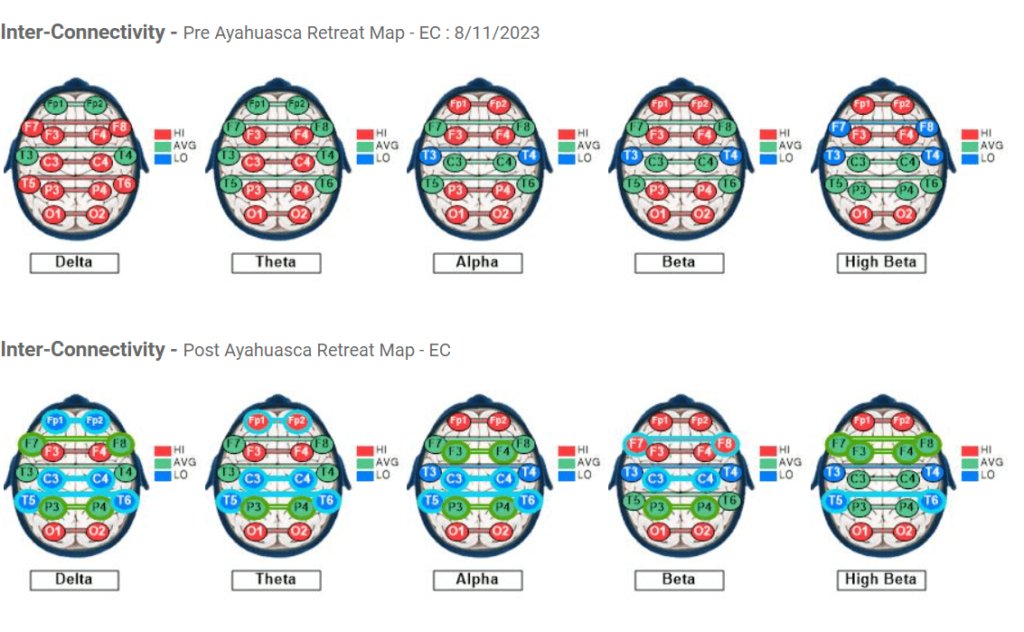
CEC results: Subject 1 experienced significant change in the pre and post Cognitive Emotional Checklist (CEC). In all categories he experienced change in a positive direction. This includes measures of attention, memory, impulsivity, depression, anxiety, and filtering. In his pre-CEC attention, impulsivity, and depression were well out of the normal range. In the post CEC attention and depression were well within the normal range and impulsivity much closer to normal range. Of all the five participants, Subject 1 experienced the most positive changes on the CEC.
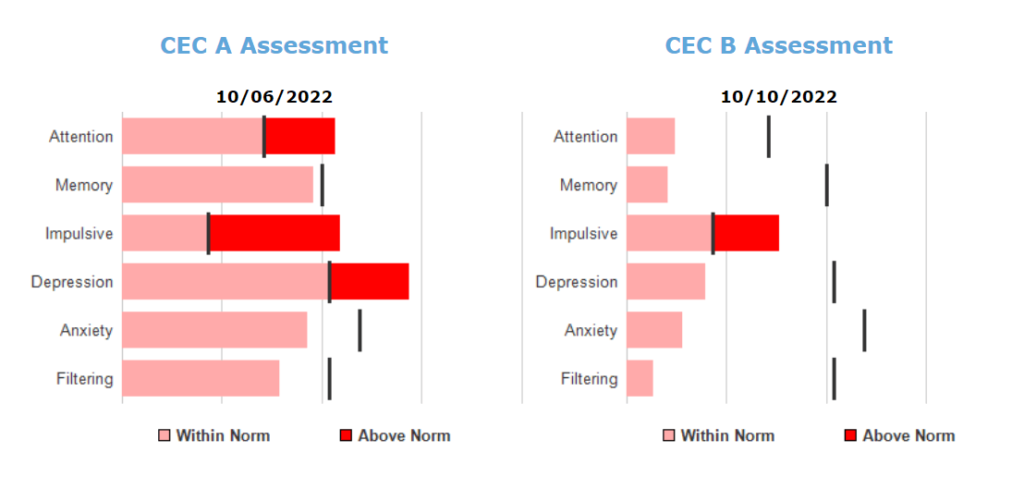
Research Subject 2 was a 41-year-old female.
QEEG results: Subject 2 had a 53% change in plasticity and a 44% change in normalization with the eyes closed pre and post map. She had a 54% change in plasticity and a 52% change in normalization in her eyes open map. Subject 2’s pre and post map had a significant change in both plasticity and normalization. She had low power in the Alpha band in the pre map that almost completely went away in the post map, an extremely significant improvement in just three days. Subject 2 also demonstrated improvement in the overall dominant frequency in the alpha band indicating normalization of the entire neurological system. Her pre map had a high-rate hypo connection (a reduction in the communication slowing of network connections), especially in the delta band and this was greatly improved in the post map, altering them into a normative range. This change indicates an increased network functioning across the brain hemispheres.
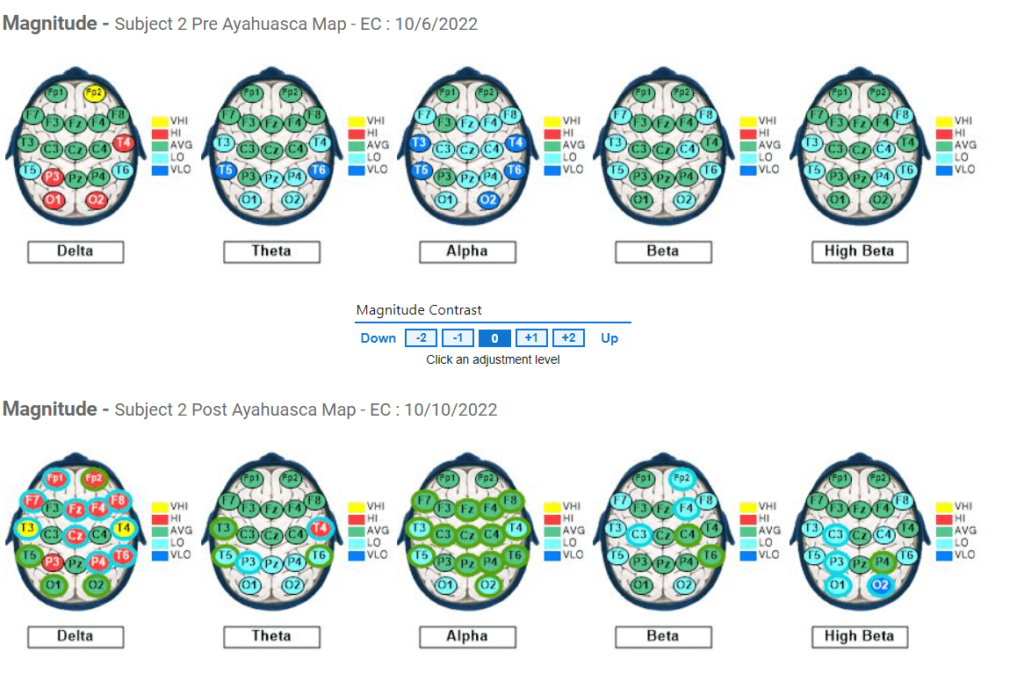
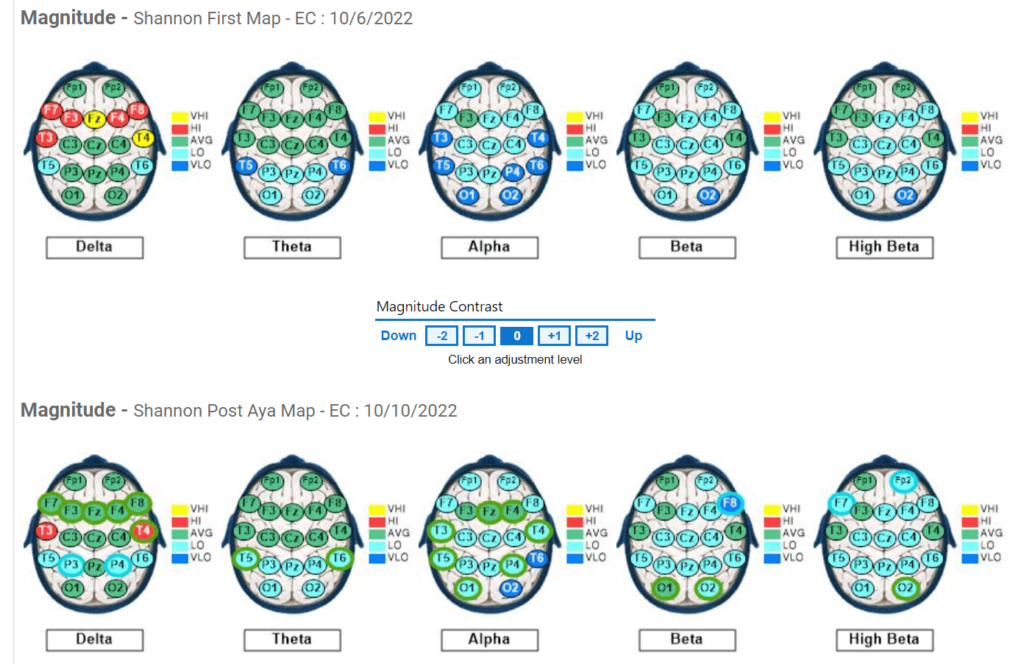
CEC results: Subject 2’s CEC results were largely the same across all categories with an increase in impulsivity in the post CEC.
Research Subject 3 was a 38 year-old female.
QEEG results: Subject 3 had a 34% change in plasticity and a 53% change in normalization in her eyes closed pre and post map. She also showed a 53% plasticity and a 65% normalization in her eyes open map, an extremely significant change. Subject 2 had high delta in her pre map that is usually indicative of head trauma or sometimes another inflammatory process. After talking to Subject 3, she reported a history of head trauma. After three days of Ayahuasca ceremonies, the high delta was significantly reduced. She stated during one ceremony the Shaman was working on her brain energetically and she felt a “healing taking place.” Her connectivity between networks was “hyper connected” in her pre map indicating a brain that is stressed and overworked. This hyper connection was reduced in the post map to a significant degree. Subject 3 also saw a significant normative increase in alpha asymmetry and a moderate increase in beta asymmetry. This would indicate a better mood along with decreased levels of depression and anxiety. Lastly, Subject 3’s eyes open map showed an impressive increase in power levels across all bands indicating a substantial increase of energy in the brain.

Subject 3’s CEC results:
Her pre-CEC indicated attention and impulsivity above the normal range and the post CEC attention went within the normal range. Her impulsivity was slightly closer to the normal range but still high. All other categories were largely the same in the post CEC.
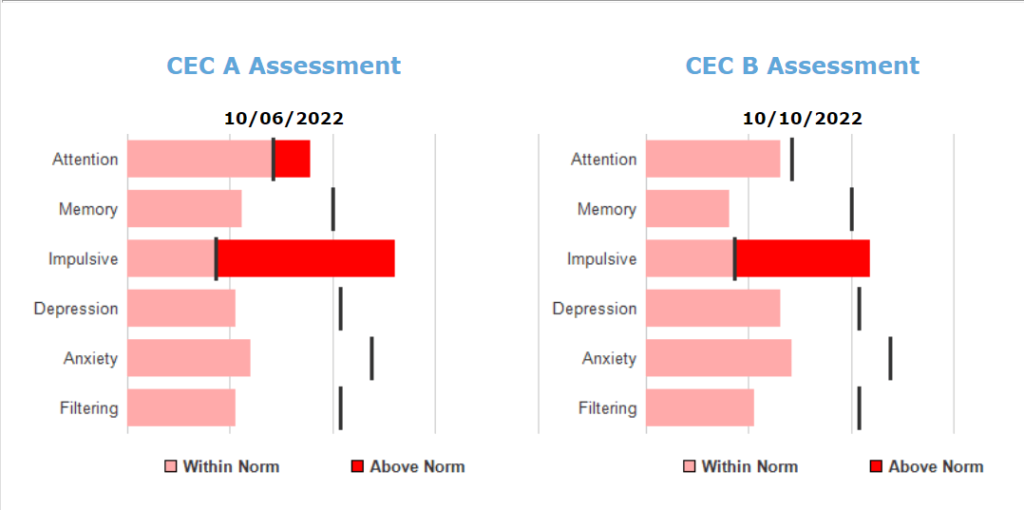
Rsearch Subject 4 was a 26- year- old male.
Subject 4 had a 47% change in plasticity and a 46% change in normalization in the eyes closed map, both very significant changes in just a few days. He also had a 40% change in plasticity and a 50% change in normalization in the eyes open pre and post map. In Subject 4’s eyes closed pre map, he had high Theta which often can make a person more impulsive. High Theta can also be associated with trouble focusing and ADD type symptoms. In the eyes closed post map this theta was completely gone. Subject 4 also had high alpha in the eyes closed map which is indicative of “perseverance” or a busy mind that can’t slow down. The post map showed a significant decrease in the alpha indicating the mind was much calmer. Subject 4 also had high beta in the posterior of the brain, and this is indicative of anxiety, negative self-talk, rumination, and PTSD. Impressively, this beta completely disappeared in the eyes closed post map.
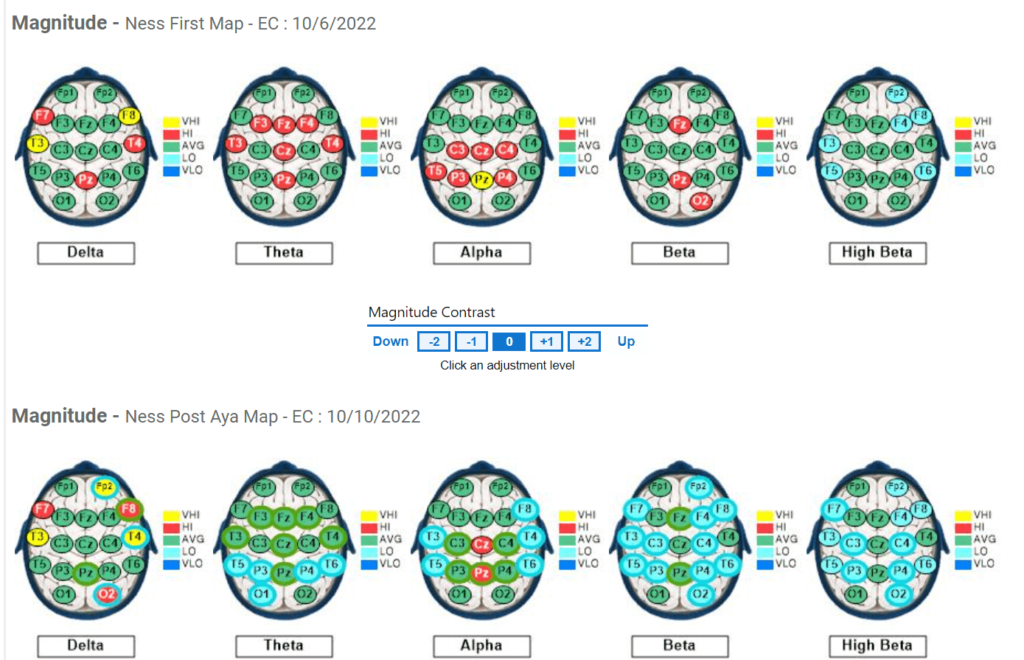
Subject 4’s CEC results:
Subject 4 experienced an extremely significant change in his pre and post CEC assessment with all categories showing dramatic improvement. This includes measurements of attention, memory, impulsivity, depression, anxiety, and filtering. Levels of depression dropped to zero in the post CEC, an extremely significant change after just three days. Attention rating was out of normal range in the pre-CEC and within the normal range in the post CEC. Subject 4 complained of having ADD like symptoms during the retreat and the CEC indicates that these symptoms decreased significantly. Interestingly, the post QEEG map reduction in theta adds validation to reduction in ADD symptoms and an increase in focus and attention.
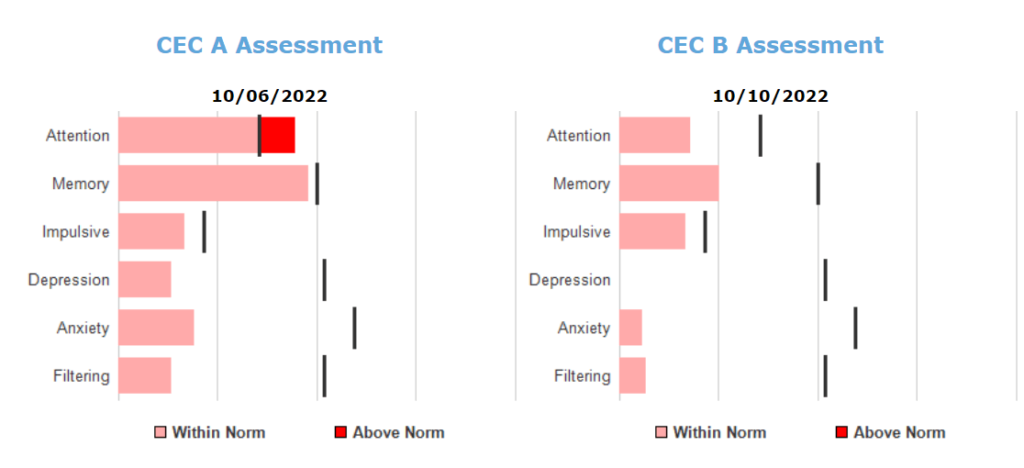
Research Subject 5 was a 25-year-old female.
Subject 5’s QEEG results: Subject 5 had a 39% change in plasticity and a 25% change in normalization in the pre and post eyes closed map. Although the eyes-closed map is the clinical map that is usually considered most important, the eyes-open map can also give insight into a client’s neuro-functioning. It is interesting to note that Subject 5 had a 41% change in plasticity and a 57% change in normalization in the eyes open post map, both very significant changes. Her power levels of her eyes closed map dropped after three days of ceremonies, likely from lack of sleep. Subject 5 had one point of high posterior alpha that went away in the post map indicating a more relaxed mind. High beta in the posterior was still exhibited in the post eyes closed map indicating emotional trauma needing further evaluation and treatment. This can be exhibited through different types of symptoms like anxiety and insomnia. Subject 5’s alpha dominant frequency increased into a normal range from a low range before indicating more robust physical brain health. Alpha and Beta asymmetry changed with alpha moving in a normative direction with beta asymmetry sliding away from a normative. This indicates the client is going through a high amount of emotional processing from the retreat and is a healthy indicator that emotional integration is taking place. The eyes open map showed a significant amount of change in power levels across all bands indicating the brain having much more energy.

Research Subject 5’s CEC results:
Subject 5 experienced a very significant amount of change in the pre and post CEC across all categories including attention, memory, impulsiveness, depression, anxiety, and filtering. Attention and memory were well out of the normal range in the pre-CEC and moved well within the normal range in the post CEC. Impulsivity was extremely out of the normal range in the pre-CEC and being only slightly out of the normal range in the post CEC.
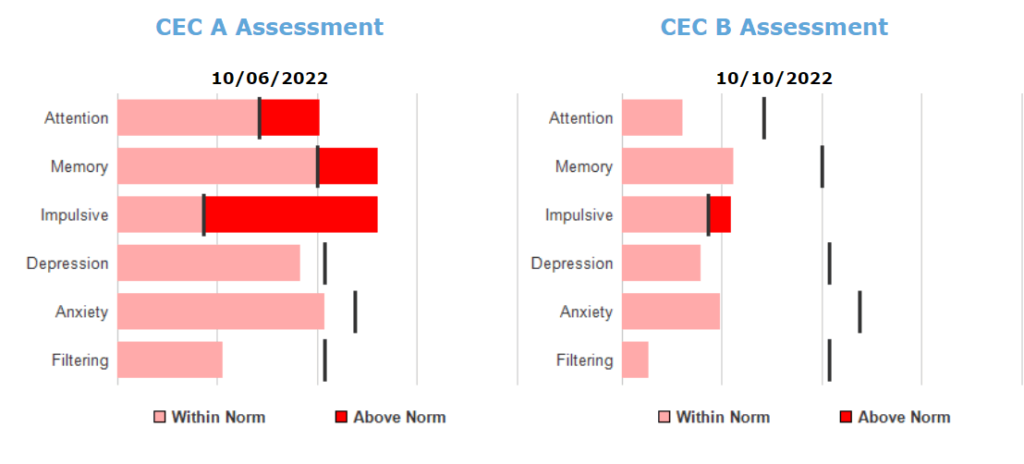
Discussion and Conclusion
The renewed interest in psychedelics has opened many new pathways of research. Of these, Ayahuasca is one of the most intriguing plants from an investigative perspective because the cultural institutions still exist surrounding the experience. Previous investigations in clinical settings have demonstrated the effectiveness of psychedelics in having a profound therapeutic effects. Now, with this study and others to follow, more field investigations will likely shed light on the therapeutic effect of Ayahuasca in the traditional ceremonial setting.
Future Ayahuasca research will likely become the combination of multiple disciplines and different research modalities. The effects of Ayahuasca itself and its effect on the neurochemistry of the brain is just one perspective. The cultural setting and history of Ayahuasca may be best viewed from an anthropological or cultural/historical perspective. The beliefs surrounding Ayahuasca might be best viewed from a philosophical and religious perspective. The healing which occurs may be best understood from a psychological perspective. The number of disciplines that could impact this subject are vast and we are only beginning of a new era of investigation.
This study brought in the unique perspective of pre and post QEEGs combined with the CEC questionnaire. This combination allowed us to track the effect over time. Tracking change over time will likely continue to be an avenue for future research because one of the major questions of those who experience and study Ayahuasca is how long do the healing effects last? For many, the insights gleaned from an Ayahuasca experience can last a lifetime, but it is also often reported that the after glow begins to fade after three to six months. An avenue of further research will be whether this change can be tracked with QEEG brain mapping? Also, another question that can be investigated is to whether we can garner insight into what kind of brain is more receptive to the experience and demonstrates longer lasting impact. What type of brain seems to have the experience fade faster? There are many questions yet to be investigated, and it is likely that some types of brain patterns may be more conducive to the Ayahuasca experience than others. Future research may even reveal what plants and psychedelics would be effective for each individual according to their brain pattern. This was a small study that took post QEEG within 24 hours after the last Ayahuasca ceremony. It would be interesting to take QEEG brain maps at different time intervals after the experience. A week, a month, and six months would potentially give a good measure of how long effects seem to last. Combining these post QEEGs with the CEC or something similar would give further insight.
To conclude, this study confirmed our hypotheses of reductions in anxiety and depression and possible QEEG changes relating to lack of sleep. The QEEG changes relating to decreased anxiety and depression were confirmed in the CEC questionnaire. These results have been observed in other studies’ questionnaires and this study confirmed these findings through QEEGs as well.
In addition to the decreased level of anxiety, we found other fascinating results. One of the truly important findings and one the most surprising was that Ayahuasca appears to have many other positive cognitive effects in a seemingly wide variety of areas. Most interesting to the research team was how after three days of participating in Ayahuasca ceremonies significantly decreased one of the subjects ADD symptoms and this was confirmed in both the QEEG and the CEC self-inventory. This research team has never heard of Ayahuasca being able to help with attention-deficit issues either in the scientific literature or from anecdotal reports. This would be a very fascinating avenue for future research. Moreover, we also saw improvements in inflammatory markers in the pre and post QEEG maps. This also demands more investigation whether the Ayahuasca brew or something in the experience itself reduces inflammation. Also, we found extremely significant changes in neuroplasticity and changes between network connections. More recent research is demonstrating the overwhelming changes in neuroplasticity in the most common psychedelics (Lukasiewicz, 202133). Our research has also thus far supported this finding as we have also observed large changes in neuroplasticity. Our study seems to demonstrate that this plasticity changed in a direction that was “needed”, not in a randomized direction or in a consistent direction. Neuroplasticity, especially within the major network connections, also holds promise for future research.
This study confirmed many of the original hypotheses that Ayahuasca would produce significant changes in the brain and would have an effect on mood, especially anxiety and depression. In addition, our research team found a wide effect on network connections, EEG power levels, measures of inflammation and other markers of neurological health. The CEC questionnaire further added validation to the changes observed in the QEEG brain maps. This initial study demonstrates how much the effects of Ayahuasca can vary from individual to individual. More studies with a similar design and larger sample size could explore these changes in greater detail in the future.
Unquestionably, Ayahuasca and other psychedelic research holds much promise. There is still much to be explored and understood in this field and the research is still in its infancy. As the 21st century progresses the enthusiasm for alternative paths for healing that psychedelics offer will only increase as the last twenty years have already demonstrated. It is likely that a new paradigm will emerge as many diverse fields of study from philosophy to physics will start to merge and cross pollinate with ancient practices such as mediation and shamanism.
References:
- McKenna DJ, Towers GH, Abbot F (1984) Monoamine oxidase inhibitors in South American hallucinogenic plants: tryptamine and beta-carboline. ↩︎
- Riba J, Romero S, Grasa E, Mena E, Carrió I, Barbanoj M (2006) Increased frontal and paralimbic activation following ayahuasca, the pan-Amazonian inebriant. Psychopharmacology 186(1):93–98. doi:10.1007/s00213-006-0358-7. ↩︎
- Hendricks PS, Thorne CB, Clark CB, Coombs DW, Johnson MW (2015) Classic psychedelic use is associated with reduced psychological distress and suicidality in the United States adult population. J Psychopharmacol Oxford, England 29(3):280–288. doi:10.1177/0269881114565653. ↩︎
- Bouso JC, Palhano-Fontes F, Rodríguez-Fornells A, Ribeiro S, Sanches R, Crippa JAS, Riba J (2015) Long-term use of psychedelic drugs is associated with differences in brain structure and personality in humans. Eur Neuropsychopharmacol 25:483–492. ↩︎
- Kuhn, Thomas S. The Structure of Scientific Revolutions. Chicago: The University of Chicago Press. ↩︎
- De Gregorio D, Aguilar-Valles A, Preller KH, Heifets BD, Hibicke M, Mitchell J, Gobbi G. Hallucinogens in Mental Health: Preclinical and Clinical Studies on LSD, Psilocybin, MDMA, and Ketamine. J Neurosci. 2021 Feb 3;41(5):891-900. doi: 10.1523/JNEUROSCI.1659-20.2020. Epub 2020 Nov 30. PMID: 33257322; PMCID: PMC7880300. ↩︎
- Weiss B, Miller JD, Carter NT, Keith Campbell W. Examining changes in personality following shamanic ceremonial use of ayahuasca. Sci Rep. 2021 Mar 23;11(1):6653. doi: 10.1038/s41598-021-84746-0. PMID: 33758236; PMCID: PMC7987971.https://doi.org/10.1038/s41598-021-84746-0. ↩︎
- Pontual AAD, Tófoli LF, Corradi-Webster CM, van Oorsouw K, Delgado ARO, Ramaekers JG. The influence of ceremonial settings on mystical and challenging experiences occasioned by ayahuasca: A survey among ritualistic and religious ayahuasca users. Front Psychol. 2022 Jul 15;13:857372. doi: 10.3389/fpsyg.2022.857372. PMID: 35911023; PMCID: PMC9335152. ↩︎
- Beissner F. Therapeutic Sensations: A New Unifying Concept. Evid Based Complement Alternat Med. 2020 Aug 6;2020:7630190. doi: 10.1155/2020/7630190. PMID: 32831879; PMCID: PMC7428881. ↩︎
- Weiss B, Miller JD, Carter NT, Keith Campbell W. Examining changes in personality following shamanic ceremonial use of ayahuasca. Sci Rep. 2021 Mar 23;11(1):6653. doi: 10.1038/s41598-021-84746-0. PMID: 33758236; PMCID: PMC7987971.https://doi.org/10.1038/s41598-021-84746-0. ↩︎
- Brabec de Mori B. The Power of Social Attribution: Perspectives on the Healing Efficacy of Ayahuasca. Front Psychol. 2021 Oct 28;12:748131. doi: 10.3389/fpsyg.2021.748131. PMID: 34777141; PMCID: PMC8581211. ↩︎
- Miller WR, & C’de Baca J (2001). Quantum Change. New York: Guilford Press ↩︎
- Griffiths RR, Johnson MW, Richards WA, Richards BD, McCann U, Jesse R. Psilocybin occasioned mystical-type experiences: immediate and persisting dose-related effects. Psychopharmacology (Berl). 2011 Dec;218(4):649-65. doi: 10.1007/s00213-011-2358-5. Epub 2011 Jun 15. PMID: 21674151; PMCID: PMC3308357. ↩︎
- Griffiths, R.R., Richards, W.A., McCann, U.et al.Psilocybin can occasion mystical-type experiences having substantial and sustained personal meaning and spiritual significance.Psychopharmacology187, 268–283 (2006). https://doi.org/10.1007/s00213-006-0457-5. ↩︎
- Griffiths R, Richards W, Johnson M, McCann U, Jesse R. Mystical-type experiences occasioned by psilocybin mediate the attribution of personal meaning and spiritual significance 14 months later. J Psychopharmacol. 2008 Aug;22(6):621-32. doi: 10.1177/0269881108094300. Epub 2008 Jul 1. PMID: 18593735; PMCID: PMC3050654. ↩︎
- Schneiderman N, Ironson G, Siegel SD. Stress and health: psychological, behavioral, and biological determinants. Annu Rev Clin Psychol. 2005;1:607-28. doi: 10.1146/annurev.clinpsy.1.102803.144141. PMID: 17716101; PMCID: PMC2568977. ↩︎
- dos Santos RG, Osório FL, Crippa JAS, Riba J, Zuardi AW, Hallak JEC (2016) Antidepressive, anxiolytic, and antiaddictive effects of ayahuasca, psilocybin and lysergic acid diethylamide (LSD): a systematic review of clinical trials published in the last 25 years. Ther Adv Psychopharmacol. doi:10.1177/2045125316638008. ↩︎
- Schenberg EE, Alexandre JFM, Filev R, Cravo AM, Sato JR, Muthukumaraswamy SD, Yonamine M, Waguespack M, Lomnicka I, Barker SA, da Silveira DX (2015) Acute biphasic effects of ayahuasca. PloS One 10:e0137202. ↩︎
- Riba J, Anderer P, Morte A, Urbano G, Jane F, Saletu B, & Barbanoj MJ (2002). Topographic pharmaco-EEG mapping of the effects of the South American psychoactive beverage ayahuasca in healthy volunteers. Br J Clin Pharmacol, 53(6), 613–628. ↩︎
- Brewer JA, Worhunsky PD, Gray JR, Tang YY, Weber J, Kober H. Meditation experience is associated with differences in default mode network activity and connectivity. Proc Natl Acad Sci U S A. 2011 Dec 13;108(50):20254-9. doi: 10.1073/pnas.1112029108. Epub 2011 Nov 23. PMID: 22114193; PMCID: PMC3250176. ↩︎
- Soutar, Richard. Holistic Neurointergration: The New Mind Model p226. ↩︎
- Muthukumaraswamy SD, Carhart-Harris RL, Moran RJ, Brookes MJ, Williams TM, Errtizoe D, Sessa B, Papadopoulos A, Bolstridge M, Singh KD, Feilding A, Friston KJ, Nutt DJ. Broadband cortical desynchronization underlies the human psychedelic state. J Neurosci. 2013 Sep 18;33(38):15171-83. doi: 10.1523/JNEUROSCI.2063-13.2013. PMID: 24048847; PMCID: PMC6618409. ↩︎
- Carhart-Harris RL, Erritzoe D, Williams T, Stone JM, Reed LJ, Colasanti A, Tyacke RJ, Leech R, Malizia AL, Murphy K, Hobden P, Evans J, Feilding A, Wise RG, Nutt DJ. Neural correlates of the psychedelic state as determined by fMRI studies with psilocybin. Proc Natl Acad Sci U S A. 2012a;109:2138–2143. doi: 10.1073/pnas.1119598109. ↩︎
- Muthukumaraswamy SD, Carhart-Harris RL, Moran RJ, Brookes MJ, Williams TM, Errtizoe D, Sessa B, Papadopoulos A, Bolstridge M, Singh KD, Feilding A, Friston KJ, Nutt DJ. Broadband cortical desynchronization underlies the human psychedelic state. J Neurosci. 2013 Sep 18;33(38):15171-83. doi: 10.1523/JNEUROSCI.2063-13.2013. PMID: 24048847; PMCID: PMC6618409. ↩︎
- Barrett FS, Griffiths RR. Classic Hallucinogens and Mystical Experiences: Phenomenology and Neural Correlates. Curr Top Behav Neurosci. 2018;36:393-430. doi: 10.1007/7854_2017_474. PMID: 28401522; PMCID: PMC6707356. ↩︎
- McEwen BS. Physiology and neurobiology of stress and adaptation: central role of the brain. Physiol Rev. 2007 Jul;87(3):873-904. doi: 10.1152/physrev.00041.2006. PMID: 17615391. ↩︎
- Soutar, Richard. Holistic Neurointergration: The New Mind Model p13 ↩︎
- Soutar, Richard. Holistic Neurointergration: The New Mind Model p13 ↩︎
- LeDoux, J. (2015). Anxious: Using the brain to understand and treat fear and anxiety. New York, NY: Viking. ↩︎
- Ross S, Bossis A, Guss J, Agin-Liebes G, Malone T, Cohen B, Mennenga SE, Belser A, Kalliontzi K, Babb J, Su Z, Corby P, Schmidt BL. Rapid and sustained symptom reduction following psilocybin treatment for anxiety and depression in patients with life-threatening cancer: a randomized controlled trial. J Psychopharmacol. 2016 Dec;30(12):1165-1180. doi: 10.1177/0269881116675512. PMID: 27909164; PMCID: PMC5367551. ↩︎
- Carhart-Harris RL, Bolstridge M, Day CMJ, Rucker J, Watts R, Erritzoe DE, Kaelen M, Giribaldi B, Bloomfield M, Pilling S, Rickard JA, Forbes B, Feilding A, Taylor D, Curran HV, Nutt DJ. Psilocybin with psychological support for treatment-resistant depression: six-month follow-up. Psychopharmacology (Berl). 2018 Feb;235(2):399-408. doi: 10.1007/s00213-017-4771-x. Epub 2017 Nov 8. PMID: 29119217; PMCID: PMC5813086 ↩︎
- Barrett FS, Doss MK, Sepeda ND, Pekar JJ, Griffiths RR. Emotions and brain function are altered up to one month after a single high dose of psilocybin. Sci Rep. 2020 Feb 10;10(1):2214. doi: 10.1038/s41598-020-59282-y. PMID: 32042038; PMCID: PMC7010702. ↩︎
- Lukasiewicz K, Baker JJ, Zuo Y, Lu J. Serotonergic Psychedelics in Neural Plasticity. Front Mol Neurosci. 2021 Oct 12;14:748359. doi: 10.3389/fnmol.2021.748359. PMID: 34712118; PMCID: PMC8545892. ↩︎